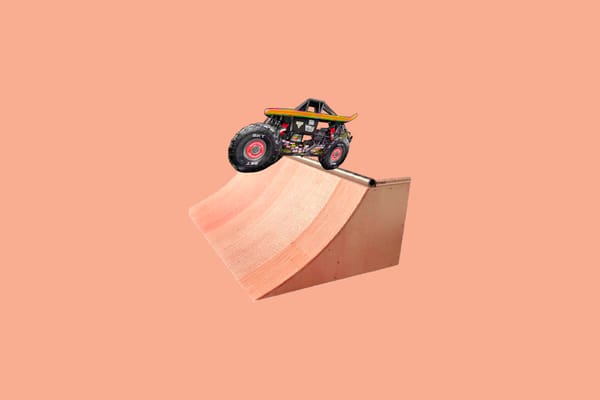You’re either going the right way or the wrong way
Plus: How much is the griptape company paying you? Mini-ramp champs, Kalis breaks his toy, and more.

The definitive weekly ranking and analysis of all the skateboarding and other online things that I cannot stop consuming and how they make me feel, personally.

How much is the griptape company paying you?
Rank: 1
Mood: 💸
This question is posed to American actor Patrick Wilson professional skateboarder Chris Colbourn, who released yet another fantastic video part just under two months after his ender section in Worble World. His most recent effort has been pushed out under the banner of griptape company Pepper. That begs the question: was this all simply footage Colbourn had lying around, or did he film a whole part for a griptape brand? Both seem likely, but the quality of tricks in the video part is not “b-roll” material.
While integral to the function of a skateboard, historically, griptape hasn’t ranked highly on the hierarchy of sponsors that a sponsored skateboarder allocates hard-earned clips. We’re accustomed to shoes, boards, apparel — and now, more regularly — wheel brands releasing full videos or individual parts. In my mind, that has always come down to two seemingly obvious things: bearings, hardware, and griptape just aren’t as sexy as their hard and soft good counterparts and (assumedly) have even less money to pay to their riders due to exceedingly large team sizes.
So how can Pepper bag itself a piece of high-level promotional material like a video part from one of the industry’s most talented names in Colbourn? Does his naturally prolific nature allow for it, Flower Suit an in-kind contribution of sorts? Or are Pepper’s coffers overflowing with ad spend thanks to the success of its exclusive G5 formula? Speaking of, did you know Pepper griptape is perforated? That each sheet is a little longer and wider than its competitors? Does any of this answer the question at hand? No! It does not! What’s next? A video part for a skate tool? (Hopefully.)

Mini-ramp champ(s)
Rank: 2
Mood: 🤼♀️
In the somewhat shallow universe of competitive skateboarding, where contests and their formats are more-or-less the same, save for a few small tweaks — a run section and maybe a best trick component à la SLS, X Games, Tampa Pro, Olympic Qualifiers, etc. — it’s nice to have the occasional outlier like Woodward’s Mano A Mano back in the fray. (Full disclosure: A game of SKATE played on a mini-ramp is tailor-made to my interests as a skateboarder who loves dorking around in the shallow end.)
Unlike a traditional flatground game of SKATE, where you are limited to whatever hard, flat surface you’re riding on, the mini-ramp opens up multiple new avenues to explore trick-wise. You can do your flip tricks but also airs, grabs, inverts, and complicated dances on the lip of the ramp. Hell, you could even manual if you’re feeling up to it. That variety is where you see an individual skateboarder’s bag of tricks open up and spill unusually cool and/or nasty maneuvers onto the competition zone.
That variety makes for interesting matchups. Can Chris Gregson do Andy Anderson tricks? Can Anderson do Gregson’s? (We’ll find out before too long, as they’re matched up in the opening round.) Sometimes that can lead to blowouts and aesthetically dreadful affairs with skaters flopping and sliming their way through offensive and defensive moves, but it’s still mostly entertaining.
I imagine that’s why Mano A Mano’s format is the way it is, where skaters alternate turns, even if they land their trick (as opposed to most games of SKATE where you keep going until you miss a landing) because if you let Andy Anderson do Andy Anderson stuff unimpeded, you’ll likely not get a trick in at all and the game comes down to who wins the rochambeau. That said, I absolutely want to see that. Also, if skaters are given two tries to land a trick instead of one and three tries on the final attempt instead of two, that could alleviate some of that pressure on defence and lessen the impact of a long offensive turn. Essentially, slap Slides & Grinds ruleset onto Mano A Mano and we’re in heaven.
Or, at the very least, enforce the rules that exist. In Jake Yanko’s match against Jake Ilardi, Yanko landed a backside-axle-stall-alley-oop-to-frontside-pivot, and the judges let Illardi get away with a backside-axle-stall-alley-oop-to-frontside-axle-stall. C’mon, guest judge Mike Sinclair.
Anyhow, if someone can pass those suggestions along to Woodward president and founder Gary Ream, that’d be much appreciated.

…this fucker was just out there skating
Rank: 66/99
Mood: 🔫
On Tuesday, Geoff Rowley turned 47 years old. In celebration, the veritable legend of professional skateboarding released an eight-minute-long video part via Thrasher Magazine’s website, apparently under the auspices of his board company Free Dome. It’s an impressive and characteristically self-serious affair. Motörhead, towering ditches, animal skulls — all of it classic Rowley. How a body that’s endured such a high level of skateboarding for so long and continues to do so is a serious feat.
Toward the end of the video, we see what appears to be a rather large spent shell of ammunition. Written on it is “FREE DOME IS NOT DEAD.”

Is that in reference to how, as of writing this, Free Dome Skateboards hasn’t hard-posted on Instagram since March 16? A banner across the top of the company’s website reads “Skate more, post less,” so maybe what’s being responded to there is just a reaction to the public’s perception of a purposefully limited online presence. Or could the words scrawled across a shell casing be some ominous and muddled political message? Maybe it speaks to something else entirely? The video part is called FREE DOME TO SKATE, so perhaps this is a somewhat confusing callout to the freeing nature of skateboarding itself.
In Rowley’s interview in the latest issue of Closer, he details the work that went into the part over the last two-and-a-half years, revealing his overall motivation for the project.
“This one is a personal thing. I needed to do something strictly for the love of it. And it’s an amazing and beautiful feeling. I don’t want anything out of it. I want people to just watch and enjoy it. And know that this fucker was just out there skating and just wanted to lay it down. That’s it.”
So, maybe that is it? Don’t think too hard. Just watch and enjoy. I’ll do my best.

20 minutes of the most fun you can have before it breaks
Rank: 2
Mood: ⏰ 🛠
For approximately two minutes and three seconds in the last week’s episode of “Out There” from Thrasher Magazine, we watch East Coast skateboarding icon Josh Kalis pilot an RC car around his backyard. There are no cuts to talking heads or updates to the rest of the piece’s core narrative. Just Kalis playing with his toy.
He gets his dog to chase it before the creature loses interest. Some relatively deft steering sees the plastic car drift across the lawn. It glides over the street of his rural-looking neighbourhood in a blur. It spins, flips, and crashes on several occasions but always rights itself and keeps going. All the while, Kalis is beaming. He is genuinely enjoying showing his toy off to his friends.
Eventually, his deft steering gives out, and he slams the RC car into a fence post, breaking its front axle. It still limps along. Kalis says the little orange machine is 20 minutes of the most fun you can have before it breaks, holding the car in the air like a hunter presenting the corpse of a rabbit. But, he says, it’s just plastic, so he can fix the toy and be back at it soon, no problem.
This theme carries throughout the episode as we watch Kalis repair the granite tiles of his indoor skatepark and struggle and fail to get a line at Muni. If you were the proprietor of a newsletter that provides commentary on skateboarding and skateboard culture, perhaps this is where you’d note that this might be an overarching theme of skateboarding itself: you might get a little beat up, broken, and defeated, but with a bit of time and care, you’ll be out there having fun again, no problem.

You’re either going the right way or the wrong way
Rank: 1
Mood: 🚫📱
Wes Kremer used to be more into photography. In the latest edition of Madare Apse’s Skate Tales for Red Bull, San Diego’s favourite son explains how with the advent of the smartphone, “You go to get a photo on a trip and then boom you got like six or seven iPhones right next to you shooting the same [thing]. It’s like, ah, diarrhea. So I kind of got over shooting photos.” Later in the video, Kremer does go to pick up a roll of film he’s gotten developed from a recent trip to France, but you know what he means.
“How Wes Kremer lives an analogue life” is the name of this episode, and while he hasn’t given up computer technology entirely, as he does have a flip phone and a computer at home and isn’t milking cows or churning butter to start each day, he has made the conscious decision not to use social media, which is a rarity in today’s culture, especially in his chosen field.
“The decade of the ‘gram. The decade of skyrocketing progression. It’s just too much… I don’t want to spend that much time on my phone. Because in reality, you see, and I see other people just getting locked in [to their phones], walking into walls while checking the feed. It’s too much… just be in the moment.”
Asking people to be “in the moment” might sound trite, but perhaps that’s because we forget what existing in the here and now means. Our anchors to the world are often what we see online, what we feed of ourselves into the feed. That constant connection to everything everywhere, through a smudged screen, can weigh on a person. Kremer’s friend and filmer, Cameron Macintosh, says that when he’s feeling that crush, Kremer will “pull you out of it, then you realize what’s going on… he’ll be that person to reign you in.”
At one point, we watch Kremer fill a neighbourhood free library box with skate magazines. “At least with a magazine, there’s an end. With the internet, with digital media, there’s no end. You keep swiping… something else is going to pop up.”
His commitment to a (mostly) offline life is admirable, even if it sometimes feels a bit bullheaded. “How do I have GPS? It’s just internal. GPWes, c’mon…” Kremer says while driving Apse to a local skatepark. “I get lost a lot, but you get to learn the landscape. It’s always 50/50. You’re either going the right way or the wrong way.”
Profound. Actually, though. But, as a public figure whose job is, in essence, to promote the products and services of the companies that sponsor him, can he continue having a viable career without using social media? Sponsors love the medium because it turns the individual into a marketing asset with trackable metrics. If brands can’t measure Kremer’s online impact, does he have any worth to them? And more importantly, is that appeasement worth it to him?
“Maybe not having social media has affected my career in a negative way. Bumming out my sponsors, you know? They’d probably appreciate it if I drive the feed a little more. That would help them out a lot, I see that aspect. But, it wouldn’t help me. I’m sticking to the principles. I don’t want to give them that piece of my life. I don’t want to get caught in the world of ‘look what I’m doing and you’re not.’ It’s a popularity contest.
“I’ll lose everything, whatever. That’s a stupid reason to lose everything just because of social media — boring. If that’s the case, I’ll go skate the other way… life will go on.”

Something to consider: When you ask your friends if they were also changed forever the day they saw Jim Gagne straight nollie flip into a pool in that one Black Label video in, like, 2004.

Good thing: “How One Dumb Woman Got On HRT In 2010” by Casey Plett for Defector, is the start of their “Histories Of Transition” series that spotlights “the experiences of trans people as they’ve worked to exist within structures that don’t want them to.”
Another good thing: Village Psychic asks Daniel Castillo, “Can You Repeat That?”
Another good thing!: It’s already gotten a lot of play (and likely got Chris Licht, the now CEO of CNN fired), but Tim Alberta’s story in The Atlantic, “Inside The Meltdown At CNN,” is worth a read if you haven’t.
Okay, one more good thing: A fun edit featuring some pals over in Victoria, BC.
Until next week… if you come across a small opening — a picket fence missing a slat, a wall vent whose cover is loose, a hole in the earth just big enough for you — crawl inside. Don’t think. Just enter and welcome whatever you find on the other side.


I wrote a book about the history and cultural impact of Tony Hawk’s Pro Skater, and I’m going to keep posting about it at the end of the newsletter for the foreseeable future. Apologies. You can pre-order Right, Down + Circle now from your favourite local bookshop, my publisher ECW Press, or all of the usual devils (Amazon, Barnes and that fucker Noble). I think you might like it.





